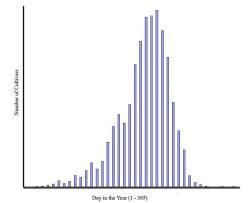...the possibility that there is no consistency in individual-garden blooming order as long as I hear that it is not considered a realistic possibility. Certainly, registered blooming seasons may be, at best, a hybridizer-locality guide only, as last year my FFO's were all over the place (below is an edited-down list, just to show the variance). I guess I will find out this summer if there is any consistency for the order in which they bloomed, which is what I am really after.
As with all living things there is a simple answer (that makes many hidden assumptions and generalizations) and a complex answer.
Simply, there will be some consistency in the order in which different cultivars bloom from year to year.
Those who like simplicity should skip the rest.
FFO (first flower open dates) are affected by both environmental factors and statistical/probability factors.
When one first grows a cultivar there are usually only two or three fans to start. Even if all the fans produce a scape there are only three values for that cultivar's FFO. So the estimate of the 'true' FFO for that cultivar will not be very good. After some years of growing that cultivar may have 20 fans that produce a scape. There are then 20 estimates of the FFO and the estimate is a good/close one of the 'true' FFO for that cultivar. What will happen with the FFO is that it will become earlier and earlier (relatively) with the passage of time and the increase in the number of fans.

The figure above shows the FFO (frequency distribution - the number of cultivars that have their FFO at specific times during the year) for a large number of cultivars. The FFOs for one cultivar would probably follow the same sort of curve. When one only has a few years of FFO dates for a cultivar it is likely that the dates will be mostly in the central section of the figure. As one gets more and more FFO dates for a cultivar it is more and more likely that one of those dates will be in the left-hand 'tail' of the figure or that the FFO will be earlier and earlier. That is the statistical problem with FFO dates.
The environmental problem is that changes in the weather can push FFO dates earlier or later. But so can changes in how a cultivar has been treated. For example, if a cultivar is divided it may bloom at a slightly different time than if it was not divided. If it had a very large number of pods set on it the previous year it may bloom at a slightly different time the next year. If it received heavy Nitrogen fertilization it may bloom at a slightly different time, and so on.
It would be simple if any and all of these sorts of possible effects were the same for all cultivars, but they are not very likely to be. Even changes in the weather that are experienced by all the cultivars in a garden may not affect them all in the same way. Some cultivars may start to flower slightly earlier if the spring has been warmer than usual but other cultivars may flower at their usual time. The effect of the weather and other environmental factors may depend on the cultivar. This is called genotype-environment interaction. In other words, a warmer than usual spring might make cultivar X bloom one week earlier than usual but it might make cultivar Y bloom two weeks earlier than usual and it might have no effect on cultivar Z which would bloom at its usual time. The sequence of FFOs for the three cultivars could then be different that year from their usual sequence.
